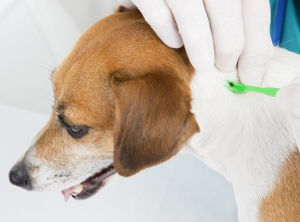 Did you know that dogs can also be infected with influenza virus. They are actually prone to influenza from pigs ("swine flu"), within their own species (canine influenza), and potentially from other species (time will tell).
At the advent of the outbreak of canine influenza in April, 2015 in the midwest, I weighed in on the topic: petMD Provides Advice to Dog Owners in Midst of Canine Influenza Outbreak.
PHILADELPHIA, PA--(Marketwired - April 09, 2015) - In response to the recent outbreak of canine influenza in the Chicago area, petMD has pulled together a Q&A to help pet owners take preventative measures and be able to quickly identify the symptoms if their pet does become infected with the virus.
Did you know that dogs can also be infected with influenza virus. They are actually prone to influenza from pigs ("swine flu"), within their own species (canine influenza), and potentially from other species (time will tell).
At the advent of the outbreak of canine influenza in April, 2015 in the midwest, I weighed in on the topic: petMD Provides Advice to Dog Owners in Midst of Canine Influenza Outbreak.
PHILADELPHIA, PA--(Marketwired - April 09, 2015) - In response to the recent outbreak of canine influenza in the Chicago area, petMD has pulled together a Q&A to help pet owners take preventative measures and be able to quickly identify the symptoms if their pet does become infected with the virus.
What is Canine Influenza?
The virus that causes dog flu, Influenza Type A (H3N8), was first identified in Florida in 2004. It primarily infects the respiratory system and is extremely contagious. Some dogs can be exposed to the virus and fight off infection without showing clinical signs.
Is My Pet Susceptible to the Virus?
"Juvenile, geriatric, and immunocompromised pets are more prone to contracting infectious diseases than healthy adults," according to petMD spokesperson Dr. Patrick Mahaney. "Environments that promote canine congregation -- such as boarding facilities and dog parks -- are also hot zones for various diseases. These sites create the potential for direct interaction or exposure to the bodily secretions of other dogs (nasal, oral, etc.) and the exchange of disease causing agents. Additionally, the stress experienced during activity, travel, or confinement commonly alters normal patterns of eating, eliminating, and sleeping, thereby negatively impacting the immune system and making our canine companions more susceptible to infection."
How Can I Prevent My Dog from Contracting the Virus?
A vaccine was granted full license by the United States Department of Agriculture in 2009 (Nobivac® Canine Flu H3N8), though it should only be considered after speaking with your veterinarian.
"Besides immunizations, it's important to provide our pets with the healthiest lifestyle possible to reduce their exposure to infectious organisms and ensure their immune systems can adequately fight off bacteria, viruses, and parasites," states petMD Contributor Patrick Mahaney, VMD. "This includes minimizing existing infectious disease in the body, such as the plethora of bacteria thriving in the canine mouth that readily enter into the bloodstream and damage the kidneys, liver, and other organs. Additionally, maintaining a healthy body condition puts less stress on all body systems and allows the blood and lymphatic vessels to more efficiently function to remove microorganisms."
What Are the Symptoms?
General symptoms include coughing, sneezing, loss of appetite, fever, and lethargy. Red and/or runny eyes and runny nose may be seen in some dogs. In most cases, there is a history of contact with other dogs that carried the virus.
Canine influenza can manifest itself in two forms:
Mild - These dogs will have a cough that is typically moist and may have nasal discharge. Occasionally, it will be more of a dry cough.
Severe - Generally, these dogs have a high fever (above 104 degrees Fahrenheit) and develop signs very quickly. Pneumonia, specifically hemorrhagic pneumonia, can develop. The influenza virus affects the capillaries in the lungs, so the dog may cough up blood and have trouble breathing if there is bleeding into the air sacs. Patients may also be infected with bacterial pneumonia, which can further complicate the situation.
How Do I Confirm My Dog Has Been Infected?
Besides a physical, your veterinarian will want to perform a series of blood tests. Dogs with canine influenza usually have an increased number of white blood cells, specifically the neutrophils, which are destructive to microorganisms. X-rays can also be taken of the dog's lungs to characterize the type of pneumonia.
Another diagnostic tool called a bronchoscope can be used to see the trachea and larger bronchi. Cell samples can also be collected by conducting a bronchial wash. These samples will typically have large amounts of neutrophils and may contain bacteria.
How Is It Treated?
Symptoms of the mild form of canine influenza last 10 to 30 days and usually go away on their own. Cough suppressants and/or antibiotics may be prescribed if a secondary bacterial infection exists. Rest and isolation from other dogs is important*.
The severe form needs to be treated aggressively with a broad spectrum of antibiotics, fluids and other general support treatments. Hospitalization and isolation are necessary until the dog is stable.
*Canine influenza is not a contagion issue for humans or other species.
About petMD
petMD is the leading online resource focused solely on the health and well-being of pets. The site maintains the world's largest pet health library, written and approved by a network of trusted veterinarians.
The following files are available for download:
Thank you for reading this article. Your questions and comments are completely welcome.
Please feel free to communicate with me through Twitter (@PatrickMahaney) and follow my adventures in veterinary medicine by liking Patrick Mahaney: Veterinarian Acupuncture Pain Management for Your Pets on Facebook.
Copyright of this article (2015) is owned by Dr Patrick Mahaney, Veterinarian and Certified Veterinary Acupuncturist. Republishing any portion of this article must first be authorized by Dr Patrick Mahaney. Requests for republishing must be approved by Dr Patrick Mahaney and received in written format.
